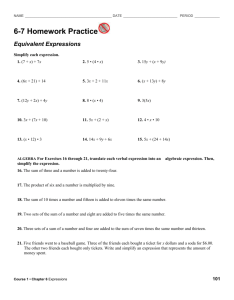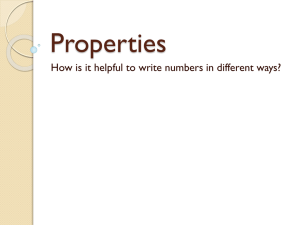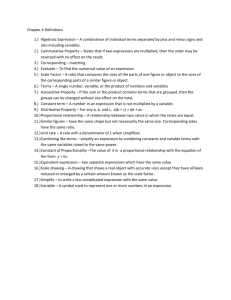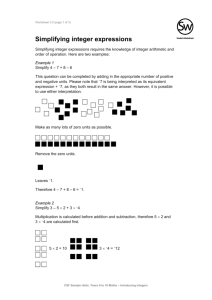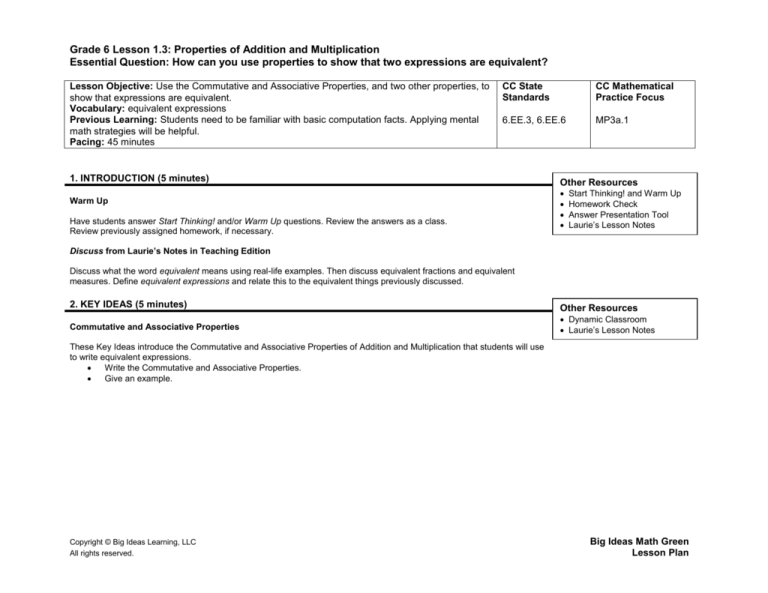
Grade 6 Lesson 1.3: Properties of Addition and Multiplication
Essential Question: How can you use properties to show that two expressions are equivalent?
Lesson Objective: Use the Commutative and Associative Properties, and two other properties, to
show that expressions are equivalent.
Vocabulary: equivalent expressions
Previous Learning: Students need to be familiar with basic computation facts. Applying mental
math strategies will be helpful.
Pacing: 45 minutes
CC State
Standards
CC Mathematical
Practice Focus
6.EE.3, 6.EE.6
MP3a.1
1. INTRODUCTION (5 minutes)
Warm Up
Have students answer Start Thinking! and/or Warm Up questions. Review the answers as a class.
Review previously assigned homework, if necessary.
Other Resources
Start Thinking! and Warm Up
Homework Check
Answer Presentation Tool
Laurie’s Lesson Notes
Discuss from Laurie’s Notes in Teaching Edition
Discuss what the word equivalent means using real-life examples. Then discuss equivalent fractions and equivalent
measures. Define equivalent expressions and relate this to the equivalent things previously discussed.
2. KEY IDEAS (5 minutes)
Other Resources
Commutative and Associative Properties
Dynamic Classroom
Laurie’s Lesson Notes
These Key Ideas introduce the Commutative and Associative Properties of Addition and Multiplication that students will use
to write equivalent expressions.
Write the Commutative and Associative Properties.
Give an example.
Copyright © Big Ideas Learning, LLC
All rights reserved.
Big Ideas Math Green
Lesson Plan
3. EXAMPLE 1 (10 minutes)
Other Resources
Focus on MP3a.1
Dynamic Classroom
Laurie’s Lesson Notes
Extra Example
Allow students to use the results from the activities to simplify algebraic expressions. Don’t let the students become
confused because of the use of a variable. The process is the same when using whole numbers, fractions, decimals or
variables.
Using Properties to Simplify Expressions
This example illustrates how the Commutative and Associative Properties are used to write equivalent expressions by
simplifying expressions such as 7 (12 x) , (6.1 x) 8.4 , or 5(11 y ) .
Work through the written examples in parts (a)–(c) as a class. Have students simplify the expression and explain
each step.
Have students work independently to answer the On Your Own questions. Then have neighbors check each
other’s work.
Review the answers together, with students presenting their work to the class.
4. KEY IDEAS (5 minutes)
Other Resources
Addition Property of Zero/Multiplication Properties of Zero and One
Dynamic Classroom
Laurie’s Lesson Notes
These Key Ideas introduce the Addition Property of Zero and the Multiplication Properties of Zero and One that students will
use to write equivalent expressions.
Write the Addition Property of Zero and the Multiplication Properties of Zero and One.
Give an example.
5. EXAMPLE 2 (5 minutes)
Other Resources
Using Properties to Simplify Expressions
Dynamic Classroom
Laurie’s Lesson Notes
Extra Example
This example illustrates how the Addition Property of Zero and the Multiplication Properties of Zero and One are used to
write equivalent expressions by simplifying expressions, such as 9 0 p or 4.5 r 1 .
Work through the examples in parts (a) and (b). Have students simplify the expression and explain each step.
6. EXAMPLE 3 (10 minutes)
Other Resources
Real-Life Application
Dynamic Classroom
Laurie’s Lesson Notes
Extra Example
This example illustrates how to write an expression and then simplify it using the properties introduced in this lesson, such
as simplifying an expression of the total amount paid by a basketball team sponsor for the league fee, T-shirts, and trophies.
Solve Example 3 with the class using Laurie’s Lesson Notes.
Have students use Think-Pair-Share to answer the On Your Own questions.
Review the answers together, with students presenting their work to the class.
Copyright © Big Ideas Learning, LLC
All rights reserved.
Big Ideas Math Green
Lesson Plan
7. ASSESS (5 minutes)
Closure (as time allows)
As a class, answer the closure question from the Teaching Edition that has students give examples of the Commutative and
Associative Properties using variables and numbers. This is a good way of summarizing the Commutative and Associative
Properties.
Other Resources
Taking Math Deeper
Mini-Assessment
Extra Practice (A and B)
Big Ideas Test Generator
Focus on MP3a.1
Allow students to practice the properties they have just learned. Have each student select an exercise from 1223 and ask
them to rewrite the problem using the Which One Doesn’t Belong format from Exercise 4. Have them trade the results with a
partner to see if they can correctly write the expression and identify the incorrect phrase.
Homework Assignment
1–4, 11–23 odd, 24–32 even
Suggestions for leveling
BASIC: Homework Assignment 1–4, 5–23 odd, 24, 25, 27
ADVANCED: Homework Assignment 1–4, 11, 12–22 even, 28–34 even
Copyright © Big Ideas Learning, LLC
All rights reserved.
Other Resources
Puzzle Time
Record and Practice Journal
Lesson Tutorials
Skills Review Handbook
Enrichment and Extension
Differentiating the Lesson
Big Ideas Math Green
Lesson Plan

